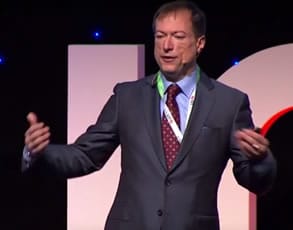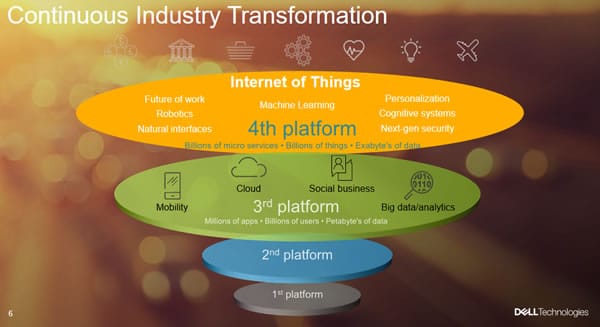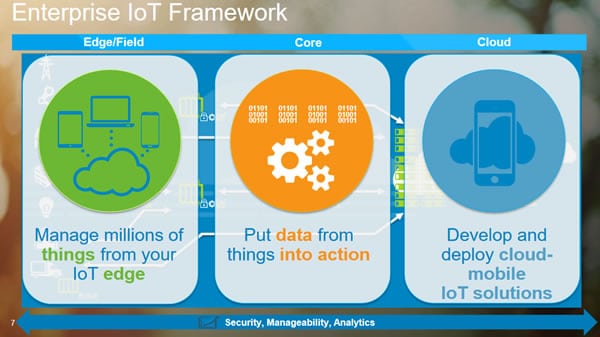Putting the Internet of Things to work. That was the theme of the IoT Solutions World Congress in Barcelona and the topic of a keynote session at the event by John Roese (Dell Technologies).
As Chief Technology Officer and EVP Cross-Product operations in the powerhouse that Dell Technologies has become since Dell acquired EMC (and with it companies like Pivotal and VMWare), John Roese needs to make sure that the technologies and solutions of the company anticipate customer needs. An interesting role for sure and reason enough to see what Roese thinks about IoT in this regard.
IoT has demonstrated that the application of technology into the physical world could have the same level of disruption as what happened in the cloud and the social world (John Roese)
IoT and the fourth industrial revolution: the digital transformation driver
After explaining the ‘innovation at scale’, end-to-end infrastructure and services, and R&D aspects of Dell Technologies, Roese said that the Industrial Internet of Things is the most transformational exercise that any company will go through for probably the next decade.

You bet it is, especially as so many disciplines and aspects are involved if you look at IoT as a foundational driver of digital transformation across the globe.
IoT needs (big) data analytics, security, artificial intelligence, changing computing paradigms, the cloud, new network models (e.g., edge computing), transformation of business processes and even new business models, the list goes on.
Roese quoted Michael Dell, chief of the ‘new’ Dell Technologies, on what the IoT means and for Dell (the man) it’s the next industrial revolution. When we talk about digital transformation and the next industrial revolution, disruption is never far away. And it’s in this context of disruption that John Roese put the Internet of Things.
Disruption in the physical world – the leading role of the industrial environment
While the almost ‘traditional’ disrupters such as Uber, Tesla and the likes “disrupt(ed)” specific industries by leveraging the digital technologies of what IDC calls the third platform (cloud, data analytics, mobile and so forth) better and faster than incumbents, the disruptive impact of the Internet of Things as it’s seen in industries across the world is more related with what you can do with a digital technology that is essentially built for the (bridging of the digital and) physical world.
John Roese: “What IoT has done, is demonstrated that the application of technology into the physical world could have the same level of disruption as what happened in the cloud and the social world.” In other words: the expectations regarding IoT are, to say the least high. But so are the levels of fear, Roese emphasized.
What is striking, despite these levels of concerns and despite their traditional attitudes towards adopting technological innovations, is that the first mover in the Internet of Things space, as you probably know, is the industrial sector.
It seems all the more striking since, as John Roese pointed out, in an industrial environment you typically build infrastructure that needs to last decades so you are cautious and normally not a first mover. We heard the same story at Internet of Things World Europe 2016 in Dublin, but then for developers.
With the IoT revolution that picture of late movers is completely different and the industrial sector is moving way faster than other sectors. Why? Because industrial companies don’t see IIoT as just technology but as existential (for their activities). In other words: not moving is not an option. And that’s good news for Dell Technologies and the others (SAP, GE, Cisco, IBM, Hewlett Packard Enterprise and all those broad but also specialized players in the Industrial Internet Consortium, from Accenture to Schneider Electric) who are focusing on that industrial world because that’s where the action, the partnerships, the revenues and the technology race to offer the best platforms and solutions are all happening.
IoT at the start of the next stage in continuous transformation
However, IoT is just at the beginning John Roese said. He stated that if we look forward ten years from now the idea of building a piece of equipment or a function that is not connected and streaming data (as is essentially what’s done in IoT and in industrial IoT: connecting entities and data), as well as using that data to influence outcomes (by turning that data into actionable intelligence of course) will just look ridiculous.
Still, despite the fact that IoT is in the make since two decades and the massive attention paid to it, reality remains that we’re still at the start today. Now we have hundreds of millions of connected devices, over the next couple of decades we’ll move to hundreds of billions, John Roese reminded.
Industrial companies don’t see IoT as just technology but as existential for their activities
Roese positions the Internet of Things in the scope of continuous industry transformation. In a graphic which he showed, he built upon IDC’s third platform view whereby the second platform was client-server and the third platform mobility, cloud, social business and big data/analytics (check it out in our piece on the DX economy).
If you know the model you also know that IDC has added a series of innovation accelerators on top of that third platform, including the Internet of Things. In Roes’ view the Internet of Things could very well be the fourth platform, building upon the second platform (which gave us the so-called systems of record) and the third, cloud-native, platform, which enabled us to deploy and deliver applications very fast and scale across a globally distributed environment, as you know.

Since the IoT Solutions World Congress took place, IDC has predicted the arrival of a fourth platform but it’s something entirely different (think man and machine, the next, integrated stage).
Still, John’s picture is clear: the Internet of Things is a big transformative shift that will not just be essential and disruptive (for the industry) but also is leading to a new industrial revolution. After all, that is what Industry 4.0 is about too.
The difference of the Internet of Things
What makes the Internet of Things different, in comparison with the third platform, John Roes said, is that we are no longer talking about serving people.
Of course people are still involved (and key in any digital transformation) but the main consumers in the IoT world will not be human beings. They are autonomously operating devices. And that, as well as the evolutions in IoT, will require more than what those crucial pillars from the second and third platform can offer.
In that perspective, according to John Roese there are three (infrastructural) challenges to be solved: a cloud challenge, an IoT edge challenge and a core problem. All three must be solved.

More about them in coming articles as they are crucial for everyone and several businesses are dealing with them. But as you can see in the screenshot of John’s presentation above it’s clear that they have to do with the fact,
- that in IoT your devices sit at the edge (and that’s why we see a mix of cloud and edge as in edge computing),
- that at the core the challenge is how to put all this data from things into action and,
- where it concerns the cloud, one of the questions concerns the development and deployment of cloud-mobile solutions.
Disclaimer: we have no relationships whatsoever with any of the mentioned people, companies or organizations mentioned in this post. All images belong to their mentioned owners.

